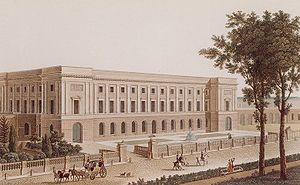
Palace of Academies
Encyclopedia

Neoclassical architecture
Neoclassical architecture was an architectural style produced by the neoclassical movement that began in the mid-18th century, manifested both in its details as a reaction against the Rococo style of naturalistic ornament, and in its architectural formulas as an outgrowth of some classicizing...
Academy Palace (Paleis der Academiën (Dutch) or Palais des Académies (French)), in Brussels
Brussels
Brussels , officially the Brussels Region or Brussels-Capital Region , is the capital of Belgium and the de facto capital of the European Union...
, establishes the harmonious ensemble of the capital's Place Royale/Koningsplein and the Brussels Park.
The Palace and its handsome stables were built between 1823 and 1828 for Prince William of Orange
William II of the Netherlands
William II was King of the Netherlands, Grand Duke of Luxembourg, and Duke of Limburg from 7 October 1840 until his death in 1849.- Early life and education :...
in recognition of his brilliant action on the field at Waterloo
Battle of Waterloo
The Battle of Waterloo was fought on Sunday 18 June 1815 near Waterloo in present-day Belgium, then part of the United Kingdom of the Netherlands...
, from funds granted by the nation. It was the joint work of two architects, Charles Vander Straeten (1771-1834) and Tilman-François Suys
Tilman-François Suys
Tilman-François Suys or Tieleman Frans Suys , was a Belgian architect who also worked in the Netherlands....
(1783-1861), at a total cost of 1,215,000 florins.
The princely family of William of Orange and his princess, Anna Pavlovna (1795-1865), sister of tsars Alexander I
Alexander I of Russia
Alexander I of Russia , served as Emperor of Russia from 23 March 1801 to 1 December 1825 and the first Russian King of Poland from 1815 to 1825. He was also the first Russian Grand Duke of Finland and Lithuania....
and Nicholas I
Nicholas I of Russia
Nicholas I , was the Emperor of Russia from 1825 until 1855, known as one of the most reactionary of the Russian monarchs. On the eve of his death, the Russian Empire reached its historical zenith spanning over 20 million square kilometers...
occupied the palace a scant two years before the Belgian Revolution
Belgian Revolution
The Belgian Revolution was the conflict which led to the secession of the Southern provinces from the United Kingdom of the Netherlands and established an independent Kingdom of Belgium....
of September 1830 forced them to flee to the Netherlands
Netherlands
The Netherlands is a constituent country of the Kingdom of the Netherlands, located mainly in North-West Europe and with several islands in the Caribbean. Mainland Netherlands borders the North Sea to the north and west, Belgium to the south, and Germany to the east, and shares maritime borders...
.
From 1830 to 1839 the palace was under sequestration by the newborn Belgian state, and a detailed inventory was drawn up. The public was allowed to tour the palace, and its interiors were considered the most sumptuous that had ever been seen in Belgium. An agreement of 5 November 1842 ceded the structure to the State of Belgium, while the contents, adjudged the personal goods of William, were shipped to his Palace of Soestdijk
Soestdijk Palace
Soestdijk Palace is a former palace of the Dutch royal family. It consists of a central block and two wings.Although named after the village of Soestdijk, which is largely in the municipality of Soest, the Soestdijk Palace is just north of the border in the municipality of Baarn in the province of...
in the Netherlands.
After housing the 1st Regiment of Chasseurs-Carabiniers, 1848-52, and having been refused by the Duke of Brabant
Leopold II of Belgium
Leopold II was the second king of the Belgians. Born in Brussels the second son of Leopold I and Louise-Marie of Orléans, he succeeded his father to the throne on 17 December 1865 and remained king until his death.Leopold is chiefly remembered as the founder and sole owner of the Congo Free...
when offered him in 1853, the palace remained in use for public festivities. The architect Gustave De Man a member of the Académie Royale de Belgique, was entrusted with transformations, finished in 1862, which fitted the building to house the Musée Moderne.
The palace
By a royal decree of 30 April 1876, the Palais was put at the disposition of the two existing Belgian academies, the Académie royale des Sciences, des Lettres et des Beaux-Arts de BelgiqueThe Royal Academies for Science and the Arts of Belgium
There are two Royal Academies for Science and the Arts in Belgium, corresponding to the two main languages of the country, Dutch and French . The Academies are located in the Palace of Academies in Brussels....
, which had been founded in 1772, and the Académie royale de Médecine de Belgique founded in 1841. Three further academies came to share the space: the Académie royale de Langue et de Littérature françaises, founded in 1920; the Koninklijke Academie voor Wetenschappen, Letteren en Schone Kunsten van België founded in 1938, called since 1999 the Koninklijke Vlaamse Academie van België voor Wetenschappen en Kunsten; and the Koninklijke Academie voor Geneeskunde van België also founded in 1938.

